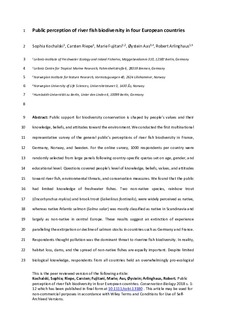| dc.description.abstract | Public support for biodiversity conservation is shaped by people’s values and their knowledge, beliefs, and attitudes toward the environment. We conducted the first multinational representative survey of the general public’s perceptions of river fish biodiversity in France, Germany, Norway, and Sweden. For the online survey, 1000 respondents per country were randomly selected from large panels following countryspecific quotas set on age, gender, and educational level. Questions covered people’s level of knowledge, beliefs, values, and attitudes toward river fish, environmental threats, and conservation measures. We found that the public had limited knowledge of freshwater fishes. Two non-native species, rainbow trout (Oncorhynchus mykiss) and brook trout (Salvelinus fontinalis), were widely perceived as native, whereas native Atlantic salmon (Salmo salar) was mostly classified as native in Scandinavia and largely as non-native in central Europe. These results suggest an extinction of experience paralleling the extirpation or decline of salmon stocks in countries such as Germany and France. Respondents thought pollutionwas the dominant threat to riverine fish biodiversity. In reality, habitat loss, dams, and the spread of non-native fishes are equally important. Despite limited biological knowledge, respondents from all countries held an overwhelmingly proecologicalworldview, supported conservation stocking, and appreciated native fishes, although only a minority interacted with them directly. Differences among the 4 countries related to several conservation issues. For example, threats to biodiversity stemming from aquaculture were perceived as more prevalent in Norway compared with the other 3 countries. Promoting fish conservation based on charismatic species and use values of fishes may work well in countries with a strong economic and cultural link to the freshwater environment, such as Norway. In countries where people rather abstractly care for nature, focusing conservation messaging on broader ecosystem traits and non-use values of fishes is likely to win more support. attitudes, biodiversity loss, communications, conservation planning, environmental threats, freshwater ecosystems, public opinion, species introduction | nb_NO |
